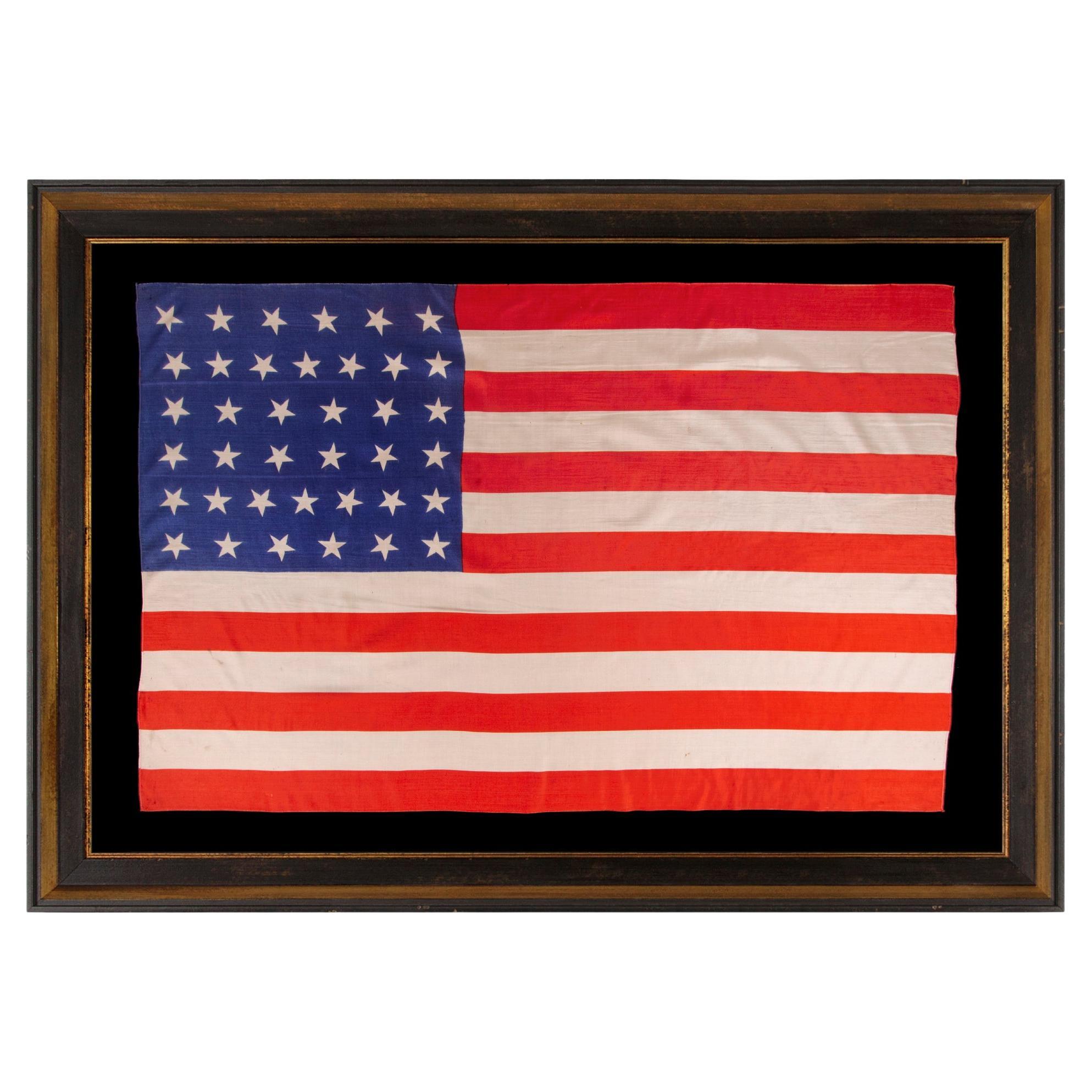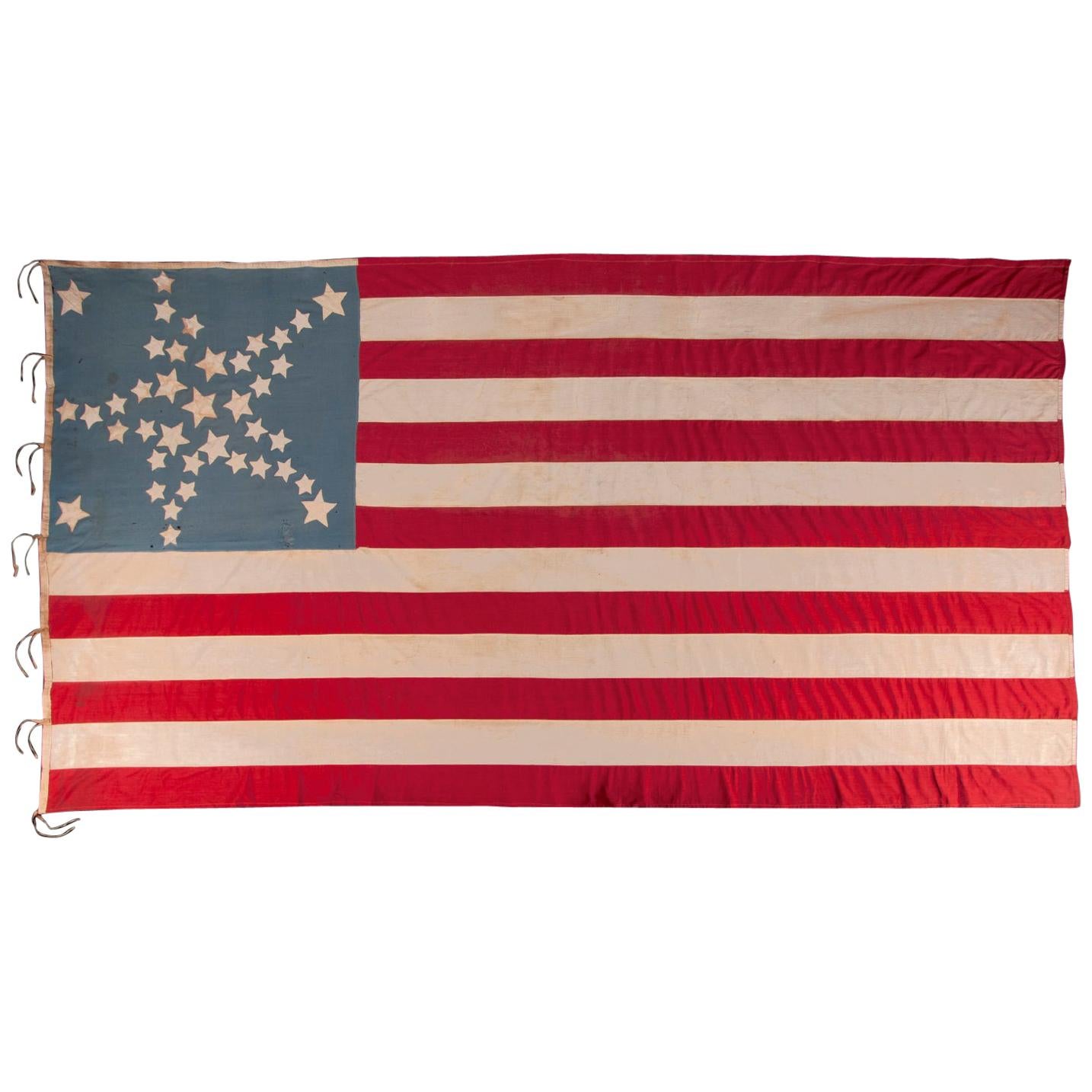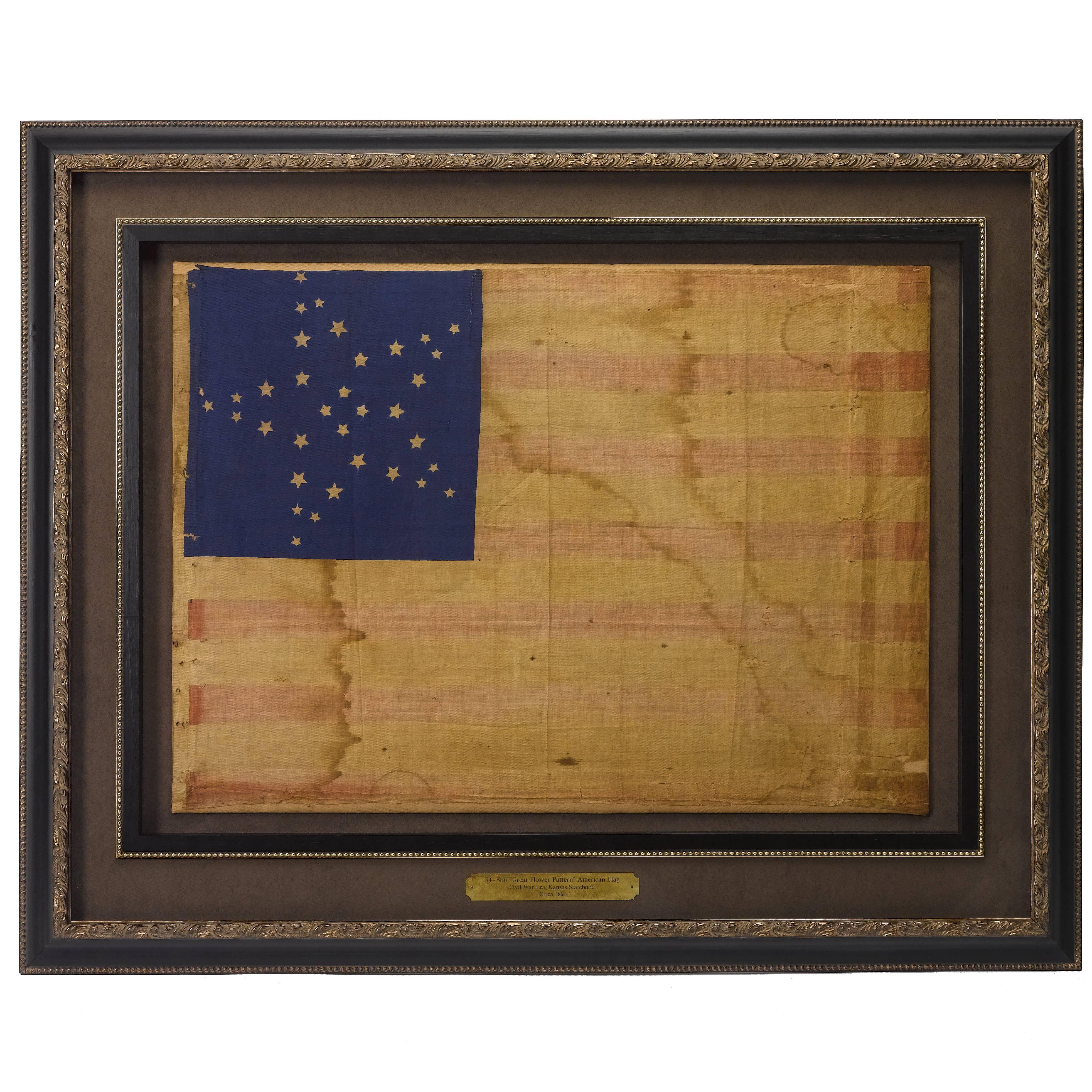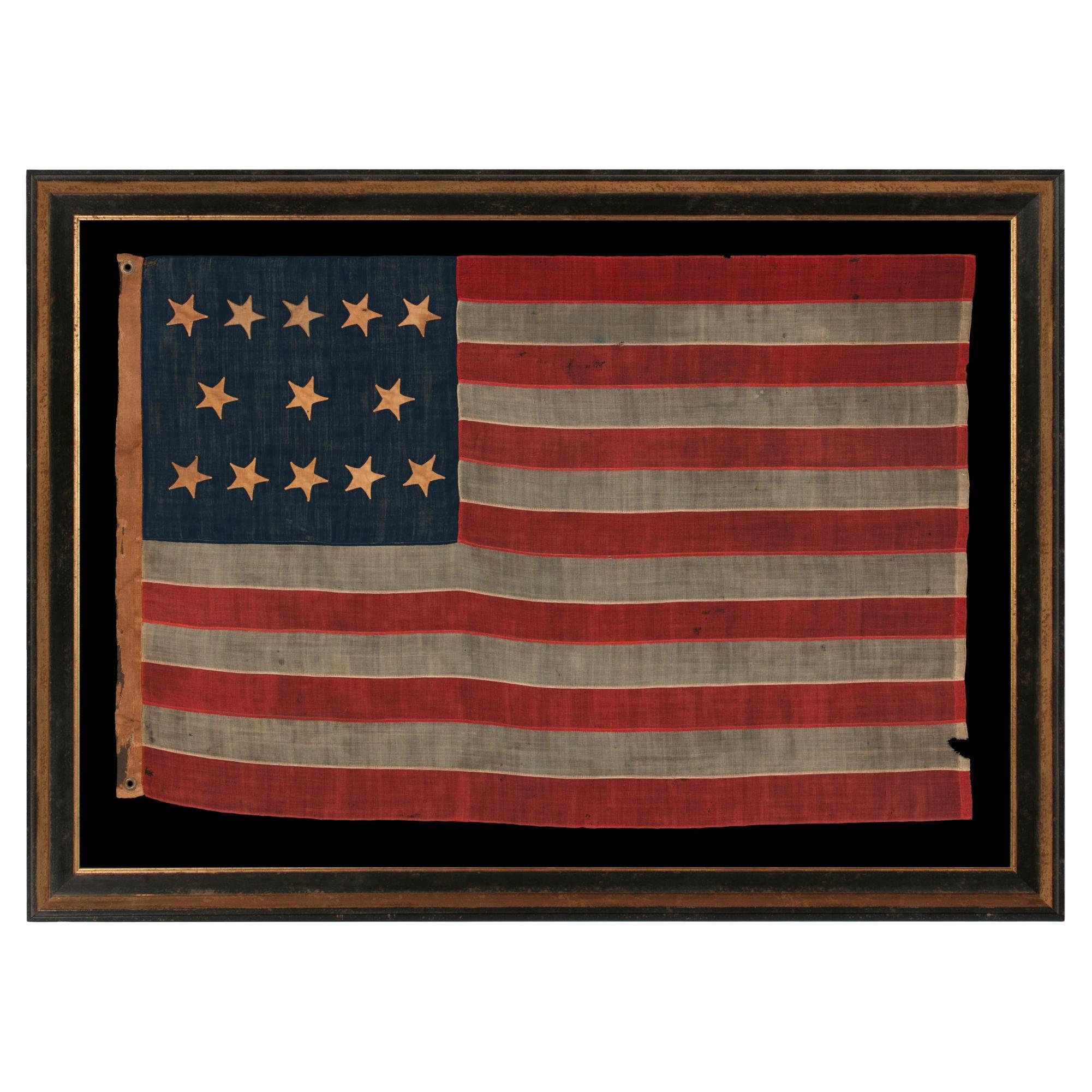Items Similar to 39-Star Antique American Flag with 'Whimsical' Star Pattern, 1889
Want more images or videos?
Request additional images or videos from the seller
1 of 6
39-Star Antique American Flag with 'Whimsical' Star Pattern, 1889
About the Item
This is a 39-star unofficial American flag, handmade and printed on cotton. The flag dates to 1889 and has a unique history, thanks to its rare star-count.
The flag’s canton is printed in a deep royal blue, with 39 five-pointed white stars. The stars are arranged in six rows, with a 7/6/7/6/7/6 star configuration. The stars are "whimsically" dyed to the flag's canton, leading us to believe this is a homemade flag. Thirteen red and white alternating stripes, which represent the 13 original colonies, complete the flag’s design.
The 39-star flag was never an official flag of America. The makers of 39-star flags gambled on the possibility of the Dakota Territory entering the Union without companions in 1877, and lost. Congress divided the Territory and admitted the North and South Dakota, Montana, Washington, and Idaho all together in 1889. As a result, this specific patriotic piece of American folk art is extremely unique.
Condition:
Flag is in good condition and flag is structurally stable. Several creases and light folds remain, mostly in centerfold, as expected with age and past use. Flag’s hoist is intact. Last two stripes are missing some fabric on fly end. Color is original and beautifully vibrant, especially in the blue canton.
The flag has been archivally presented, mounted floating and framed in a custom-built wooden frame.
- Dimensions:Height: 32 in (81.28 cm)Width: 40.5 in (102.87 cm)Depth: 1.75 in (4.45 cm)
- Materials and Techniques:
- Place of Origin:
- Period:
- Date of Manufacture:1889
- Condition:Additions or alterations made to the original: Archival mounting and framing by Art Source International in Boulder, Colorado. Wear consistent with age and use. Minor losses. Flag is in good condition and flag is structurally stable. Several creases and light folds remain, mostly in centerfold, as expected with age and past use. Flag’s hoist is intact. Last two stripes are missing some fabric on fly end.
- Seller Location:Colorado Springs, CO
- Reference Number:
About the Seller
4.9
Platinum Seller
These expertly vetted sellers are 1stDibs' most experienced sellers and are rated highest by our customers.
Established in 2010
1stDibs seller since 2011
402 sales on 1stDibs
Typical response time: <1 hour
- ShippingRetrieving quote...Ships From: Colorado Springs, CO
- Return PolicyA return for this item may be initiated within 10 days of delivery.
More From This SellerView All
- 34-Star Civil War American Flag, Antique Great Star Pattern, circa 1861Located in Colorado Springs, COThe stars of this extremely rare, Civil War-era flag are arranged in what is sometimes called the "Great Flower" pattern, a large star made out of smaller stars -- named as such beca...Category
Antique 1860s American Political and Patriotic Memorabilia
MaterialsLinen
- 41-Star Printed Flag Waver, Celebrating Montana Statehood, 1889Located in Colorado Springs, COPresented is a very rare, 41-star flag waver celebrating Montana statehood. The flag is printed on linen and dates to 1889. The dark blue canton is printed with forty one stars in nine rows of alternating counts of five and four stars. Thirteen red and white stripes complete the flag’s design. The history of Montana statehood is a long one. Numerous Native American tribes originally inhabited the Montana Territory. Meriwether Lewis, William Clark, and the members of their expedition were the first explorers to document a journey through Montana and the lands of the Louisiana Purchase. Soon, forts were established to facilitate regular fur trading with Native American tribes. Missionaries and trailblazers followed. The discovery of gold in the early 1860s sped the creation of the Montana Territory. As settlers and gold prospectors entered Montana in the 1860s and 1870s, conflicts with the Native Americans arose. Perhaps the most famous clash between Native Americans and the United States military occurred in Montana on June 25, 1876. On that day, Sioux and Cheyenne defeated Lieutenant Colonel George Armstrong Custer‘s 7th United States Cavalry regiment at the Battle of the Little Bighorn. A year later, Nez Percé Chief Joseph surrendered in the Bear Paw Mountains of Montana. Lured by copper in the 1880s, mining brought even more settlers to Montana. Rich grazing lands for cattle and sheep attracted other pioneers. Each of the states in America, with the exception of the original thirteen, Texas, and California, was first organized as a territory before achieving admittance to the Union as a state. Originating with the Ordinances of 1785 and 1787, the territorial system provided the expanding U.S. with a method to govern frontier areas until they gained sufficient population and economic maturity to qualify for statehood. Not surprisingly, residents of frontier territories usually demanded quick admission to statehood so they could gain full control of their local governments. Montana was a territory for 25 years – from the creation of Montana Territory in 1864 until the territory was admitted to statehood in 1889. On November 2, 1889, North and South Dakota were added to the Union as the 39th and 40th states, the first time in history that two states were admitted on the same day. Montana became the 41st state on November 8, predating Washington, the 42nd state, by only three days. Flag makers were not in the business of making out-of-date flags. As a result of these rapid changes in the number of states, only a small number of 41-star flags or commemorative items were ever produced, thereby making any 41-star flag exceedingly rare. CONDITION: Good condition. This flag is printed, with a hemmed headband and fly end in a running stitch...Category
Antique 1880s American Political and Patriotic Memorabilia
MaterialsLinen
- 38-Star Antique American Flag with Unique Canton, circa 1876-1890Located in Colorado Springs, COThis is a striking 38-star American flag. The flag dates to 1876-1890, when Colorado (represented by the large star in the center of the flag’s canton) joined the Union as the 38th s...Category
Antique Late 19th Century American Political and Patriotic Memorabilia
MaterialsMuslin
- 46-Star American Flag Printed in Drum Star ConfigurationLocated in Colorado Springs, COThis is an original 46-Star American parade flag, celebrating Oklahoma statehood. Each star on the flag's canton represents a state in the Union at the time. The official flag design would update every July 4th, to include any new states added to the Union in the past year. Oklahoma, the 46th state, entered the Union on November 16, 1907. As such, this 46–star flag was the official flag of the United States from July 4, 1908, until July 4, 1912. The silk flag has a dark blue canton with 46 white printed stars. The stars are printed in an 7-8-8-8-8-7 row configuration, or “Drum design.” The flag design is completed with 13 alternating red and white stripes, each stripe representing one of the original thirteen colonies. The land that comprises Oklahoma today was added to the United States as part of the Louisiana Purchase of 1803. Throughout the 19th century, the U.S. government relocated Indian tribes from the southeastern United States to the area, and by 1900, over 30 Indian tribes had been moved to what was originally called the Indian Territories. At the same time, ranchers in Texas began to move into the area in search of new pasture lands. Although stipulations in the Indian Relocation Act agreed that the land would forever be Indian Territory, the promise of fertile farmland trumped the government’s promise of sovereignty. On April 22, 1889, they opened the land to settlement by homesteaders, creating a land run in which settlers, called “Boomers,” were allowed to cross the Texas or Arkansas border at a particular hour to claim homesteads. Settlers who illegally crossed the border earlier to stake prime land were called “sooners,” which eventually became the state’s nickname. Wagons and the Santa Fe railroad carried cartloads of men and women to blank town sites and building plots, creating ten thousand-people communities in a matter of days. The following year, the region was further divided into Indian Territory and Oklahoma Territory...Category
Vintage 1910s American Political and Patriotic Memorabilia
MaterialsSilk
- 46-Star American Flag, Antique Printed on Silk, Early 20th CenturyLocated in Colorado Springs, COThis is an original 46-star American parade flag, printed on silk. Each star represents a state in the Union at the time. The official flag design would update every July 4th, to inc...Category
Antique Early 1900s American Political and Patriotic Memorabilia
MaterialsSilk
- 31-Star Printed American Flag, Celebrating California Statehood, Circa 1850Located in Colorado Springs, COThis is a rare 31-star medallion printed American flag, celebrating the addition of California to the Union. The flag is printed on silk and has a spectacular “Great Star” canton pat...Category
Antique 1850s American Political and Patriotic Memorabilia
MaterialsSilk
You May Also Like
- 1889 North Dakota 39 Star United States of America Statehood FlagLocated in Coeur d'Alene, ID39 star silk statehood flag. 23 1/2" x 15". Was the unofficial North Dakota Flag. As South Dakota was also admitted as the 40th state on the same day this...Category
Antique 1880s American Historical Memorabilia
MaterialsSilk
- 38 Star American Flag, Stars in Notched Pattern, ca 1876-1889Located in York County, PA38 HAND-SEWN STARS IN A "NOTCHED" PATTERN, ON AN ANTIQUE AMERICAN FLAG WITH BEAUTIFUL WEAR FROM HAVING BEEN EXTENSIVELY FLOWN, MADE AT THE TIME WHEN COLORADO WAS THE MOST RECENT STATE TO JOIN THE UNION, 1876-1889 38 star Antique American flag, made during the period when Colorado was the most recent state to join the Union. The stars are arranged in what is known as a "notched" pattern, in which two spaces were left open along the hoist end, in the first and last rows, in anticipation that two more Western Territories would soon join the Union. The latter 19th century was a time of when much of the land in and about the Continental Divide was formalized into states, and there was continual speculation about which ones would be accepted next, and with what boundaries. The stars of the flag are made of cotton and are double-appliquéd (applied to both sides) with a lineal, treadle stitch. The canton and stripes of the flag are made of wool bunting that has been pieced with treadle stitching. The canton was constructed from five separate lengths of fabric, which is an unusual feature, though hardly unknown. To each of these a row of stars was sewn. This manner of construction is sometimes encountered and tends to be an early trait, at least when it occurs in flags of this scale and smaller. When encountered, it also seems to have been preferred in flags meant for maritime use. While the feature does not by any means guarantee this fact, it is a reasonable, educated guess, based upon my examination of many other examples. A flag with a 5-piece canton, such as this, would have been less likelihood to stretch, with increased structural integrity. The alternative is that this was simply an example made when there were at least five pieces of leftover fabric, of a reasonable size to made individual rows, and that what it actually demonstrates is the careful conservation of scarce resources. There is a sailcloth canvas binding along the hoist, with 3 brass grommets, evenly spaced. Perhaps the best feature of the flag is the evidence it displays of having been extensively flown, with the fly end whipped out from wind exposure. While many flags display damage from a combination of having been flown, exposure to the elements, various mishaps, and improper storage, very few exhibit wear such as this, which is both endearingly and visually attractive. This one shows its age beautifully, whipped out along the fly end, with losses that convey an element of movement, that most flags don’t capture in the state in which they survive. Colorado became the 38th state on August 1st, 1876. This was the year of our nation’s 100-year anniversary of independence. Per the Third Flag Act of 1818, stars were not officially added until the 4th of July following a state's addition. For this reason, 37 was the official star count for the American flag in 1876. Flag-making was a competitive venture, however, and few flag-makers would have been continuing to produce 37 star flags, when their competitors were making 38’s. It is for this reason that 38 and 13 stars (to represent the original 13 colonies...Category
Antique Late 19th Century American Political and Patriotic Memorabilia
MaterialsWool
- 38 Star Antique American Flag, Colorado Statehood, ca 1876-1889Located in York County, PA38 star antique American parade flag with scattered star orientation, made of silk, with generous scale and vivid colors, Colorado Statehood, 1876-1889 38 star American national p...Category
Antique Late 19th Century American Political and Patriotic Memorabilia
MaterialsSilk
- 34 Star American flag, Updated to 39 Stars, with Stars in a Great Star PatternLocated in York County, PA34 STARS IN A WHIMSICAL RENDITION OF THE GREAT STAR PATTERN, ON A CIVIL WAR PERIOD FLAG WITH A CORNFLOWER BLUE CANTON, UPDATED TO 39 STARS IN 1876 34 star American national flag with additional stars added and one of the most stunning graphic designs I have ever seen in early flag-making. The original pattern was comprised of a circle of 5 large stars, and triangular arms made of smaller stars. These are noticeable pointy and bent like the arms of a starfish. Made of cotton, the stars are hand-sewn and double-appliquéd to a fantastic, cornflower blue canton, a color common to Civil War uniforms...Category
Antique 1870s American Political and Patriotic Memorabilia
MaterialsCotton
- 13 Star Antique American Flag with Hand-Sewn Stars in 5-3-5 Pattern, ca 1861-65Located in York County, PAAntique American flag with 13 hand-sewn stars in an extremely rare lineal configuration of 5-3-5, probably made with the intent of use by local militia or private outfitting of a vol...Category
Antique 1860s American Political and Patriotic Memorabilia
MaterialsWool
- 36 Star Antique Flag, Nevada Statehood, with Stars in the "Great Star" PatternLocated in York County, PA36 STARS IN THE "GREAT STAR" OR "GREAT LUMINARY" PATTERN, ON A MERINO WOOL FLAG OF THE CIVIL WAR ERA WITH BEAUTIFUL SCARLET AND ROYAL BLUE COLOR AND WITH ITS CANTON RESTING ON THE "WAR STRIPE," REFLECTS NEVADA STATEHOOD, 1864-67 36 star antique American flag of the Civil War era, with some rare, desirable, and beautiful features. The most obvious of these is the configuration of the stars. These are arranged in what is known as the “Great Star” or "Great Luminary" pattern, a star made out of stars, which is one of the most graphic and desired geometric designs among flag enthusiasts. Nevada entered the Union as the 36th state on October 31st, Halloween, in 1864. Ushered in by Abraham Lincoln just eight days before the presidential election that resulted in his second term, the territory’s wealth in silver was attractive to a nation struggling with the debts of war and so increased support for the Republican ticket. The 36th star was officially added on July 4th, 1865, but since the flag makers generally cared very little about official star counts, the production of 36 star flags began much earlier. The makers of printed flags are known to have begun adding the 36th star as early as July of 1864, several months before the addition of Nevada actually occurred. This was a common practice during the late 19th century and is reflective of both the nation's desire for Westward Expansion and the hope of flag-makers to bring new star counts to market before their competitors. The 36 star flag was officially replaced by the 37 star flag in 1867, following the addition of Nebraska. Great Stars come in many forms. This particular example has a single center star, surrounded by a pentagon of 5 stars, set inside its star-shaped perimeter. Note how the Great Star is positioned with two points up instead of one and so is effectively upside-down with respect to modern convention. Unlike the current flag, versions of the Stars & Stripes made during the 19th century and prior often displayed stars that were varied or completely random in their rotation on a vertical axis. Note how the feature draws attention and is unusual to the eye, in addition to being visually appealing. Another interesting trait can be seen in the fact that the canton rests on a red stripe. When this scarce condition occurs, some flag historians have referred to it as the “blood stripe” or the “war stripe”, suggesting the flag was constructed in this manner when the nation was at war. In actuality, the placement probably occurred more often by accident. Not everyone knew where the canton was traditionally positioned, and because there was no official specification until 1912, there was no official placement. Whatever the case may be with regarding the reason, the war stripe feature is highly coveted by collectors. The stars of the flag are hand-sewn, made of cotton, and are double-appliquéd (applied to both sides). The canton and stripes of the flag are made of fine merino wool. These are beautiful, luxurious fabrics with strong royal blue and scarlet color. Every seam was joined with a row of hand-stitching, then finished with a row of treadle stitching. Instead of employing the selvage edge of the red fabric, the top and bottom edges of the flag were turned under and seamed by hand and the fly end was seamed in the same fashion. There is a narrow binding along the hoist, treadle-sewn and made of cotton. Along this five cotton tabs were affixed, each with a tiny brass ring, which suggests that the flag was probably affixed to a wooden staff with twine or ribbon and hand-carried. The name of "Stow" is inscribed along the hoist. This would be the name of a former owner. In the field of early American flags...Category
Antique 1860s American Political and Patriotic Memorabilia
MaterialsWool





